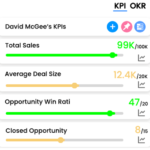Key Performance Indicators Examples

Design consistency
Design consistency refers to the degree to which the design elements, such as visual elements, typography, and layout, are used consistently across different projects and materials. This consistency helps to create a coherent and recognizable brand identity, and makes it easier for customers to recognize and understand a company’s products and services.
Design consistency can be measured in several ways, such as:
Design guidelines adherence: This refers to the degree to which the design team adheres to the company’s established design guidelines.
Brand consistency: This refers to the degree to which the design of different products, services, or materials is consistent with the company’s brand identity.
UI consistency: This refers to the degree to which the design elements and user interface are consistent across different platforms and devices.
Interaction consistency: This refers to the degree to which the design elements and interactions are consistent across different projects, platforms and devices.
Design consistency KPI can be used to measure the effectiveness of design team’s adherence to guidelines and to track improvements over time.
Measure what matters for your business with KPIs
Track business performance with real time key metrics against targets in one place without the need for multiple dashboards or reports
